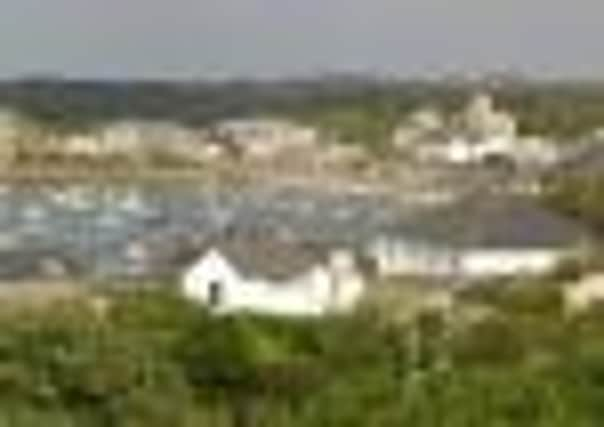Scilly seasons


A stone’s throw from the Cornish coast claims the brochure promoting the Scilly Isles. That would be quite a throw. They are actually 28 miles south-west of Land’s End. As you fly in, a huddle of beach-fringed islands appear out of nothing, like an atoll in the Pacific.
As I found out over the next three days, they are a world apart and in a world of their own, each of the islands equating to a state. Scilly has the remote appeal of the Scottish islands but the reassuring cosiness of Middle England.
Advertisement
Hide AdAdvertisement
Hide AdScilly is a small world too. There’s essentially one road which runs for nine miles around the interior of the main island, St Mary’s. The airport minibus driver joked that Hugh Town, the sole village, was “the city centre”. The scale of the street map is in furlongs and, even with a more familiar Ordnance Survey map, it took me a while to come to terms with the diminutive size of St Mary’s during a bike ride around it on my first two evenings.
My favourite beach on St Mary’s was the first I came to, Porth Hellick Bay. At the back of the beach – deserted when I visited – is a memorial to the splendidly named Admiral Sir Cloudesley Shovell. His body was washed up here when his flagship, the HMS Association, was shipwrecked in 1707. Three other ships went down in the same storm with the loss of 1,628 lives.
A little further round the coast is a considerably older grave – a burial chamber dating back to the Bronze Age. Chambers and other antiquities dot the northern shore of the island and provide welcome places to rest, explore and admire the coastal views.
From the Iron Age village at Halangay Down I could make out the long beach and red and white striped navigation tower on St Martin’s, a lighthouse like a candle on the pudding-shaped Round Island, the ragged outline of four peaks, the woods of Tresco, and finally, the rounded profiles of Bryher and Samson.
Advertisement
Hide AdAdvertisement
Hide AdMy appetite for some island hopping was thoroughly whetted. Bright and early the following morning I joined in a sort of school run of holidaymakers streaming out of their B&Bs. We paused to get sandwiches from the Co-op en route to the harbour to choose from excursions chalked up on the blackboards.
The place is a boat-trippers paradise. Vessels go everywhere and no voyage takes long. I chose Tresco, best known for its, Abbey Gardens. They were developed from 1834 by four successive generations of the same family, shelter being provided by the walls of a ruined 12th century priory together with some new walls and a screen of trees. Covering 17 acres, the terraced gardens now contain more than 4,000 different specimens from all five Mediterranean zones in the world. My favourite was the freakish araucariaceae from Norfolk Island that looked like an artificial Christmas tree. The gardens are a must visit but I preferred Valhalla, the national maritime collection of salvaged ship’s figureheads. There was something melancholy and tragic about row upon row of figureheads glaring toward the foliage of the gardens rather than across the ocean swell. The name of one ship recalled in a name board among the exhibits was partly poignant: Intrepid.
Privately owned, Tresco is truly beautiful – but almost too immaculate and a little bit exclusive-feeling. The following day, in search of an island that was more of a real life community, I headed to St Agnes.
Like Gugh, its neighbour reached by a sand spit at low tide, St Agnes is dotted with weird and wonderfully shaped lumps of granite – like a kind of Brimham Rocks on Sea. And what a sea. The water is crystal clear and Caribbean blue and the white sand granular and clearly derived from crushed shells.
Advertisement
Hide AdAdvertisement
Hide AdThe sole mode of transport is golf buggies, some even with number plates. Most people walk – a gentle stroll around St Agnes takes no more than half a day and includes a maze originally made out of large pebbles by the lighthouse keeper’s son in 1729. Today the lighthouse is a family home and tomatoes are grown in the lantern room. Unlike most things on St Agnes including the Turk’s Head pub, handily placed beside the quay, the lighthouse can’t, however, lay claim to being the most south-westerly in the UK.
That honour goes to the Bishop Rock lighthouse – another four miles out to the sea – which I’d visited during the morning half of the trip.
After fish and chips on the beach, I nipped back to the harbour to join the crowds squinting into the sunset to watch the pilot gig racing. Gigs are traditional, 32ft-long Scillonian rowing boats and the race we saw – which started from Samson – involved eight boats crewed by six women and a cox. When the competitors passed the end of harbour wall they flopped over their oars and eased the gigs around the corner, their bright colours highlighted by the low sun.
Boats had become a theme of the holiday and encapsulated the perils and pleasures of such an isolated island existence.
Getting there
Advertisement
Hide AdAdvertisement
Hide AdDirect flights from Bristol, Southampton, Exeter, Land’s End, Newquay and Penzance with connections from other airports nationwide. Helicopter and ferry from Penzance. See islesofscilly-travel.co.uk.
Weblink: simplyscilly.co.uk.
Recommended accommodation: Isles of Scilly Country Guest House, St Mary’s. scillyguesthouse.co.uk/01720 422440. Peaceful, airy and comfortable accommodation with sitting room and kitchen in the centre of the island. Doubles up as a Bavarian kaffeehaus by day.